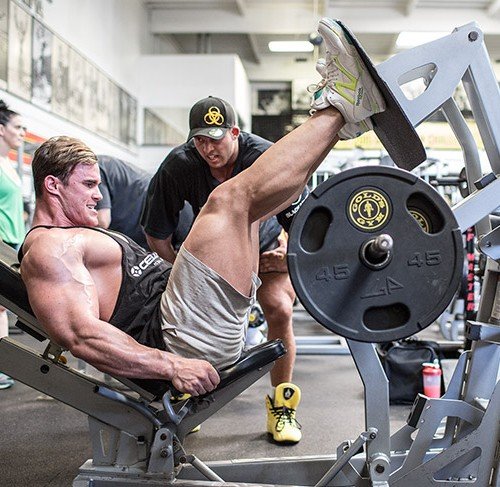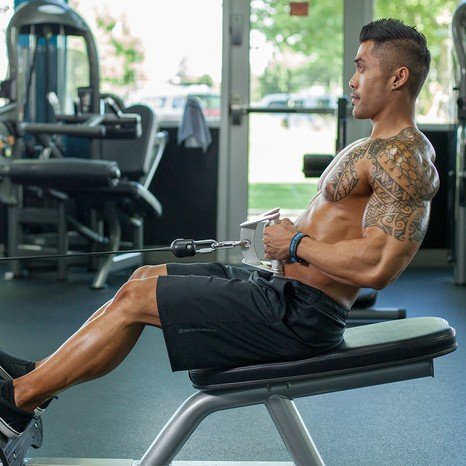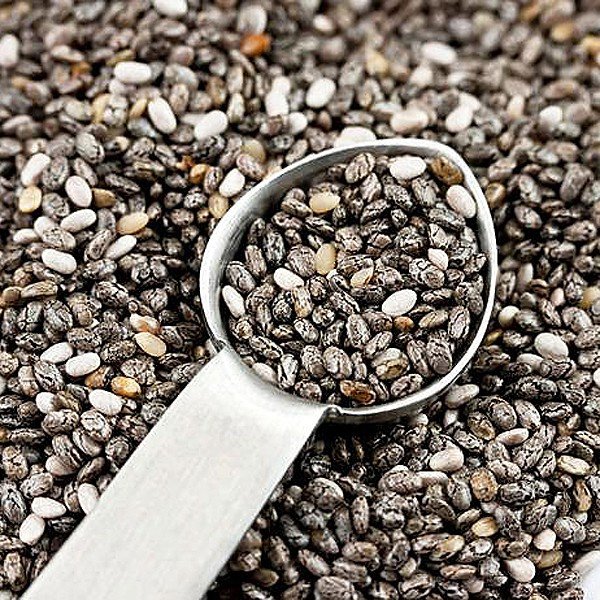There's an unfortunate progression that many people fall into in their training:
- Hit it
- Hit it harder
- Get injured
- Back off
- Repeat steps 1-4
Compared to many other physical activities, lifting is a surprisingly safe pursuit. But there's a fine line between building your grit and toughness, and putting yourself at risk of ending your training career. As someone who has been at this for a few decades, I'm here to hold a mirror up to those times you're just a little Too confident that nothing bad could ever happen to you.
If you're guilty of making yourself susceptible to some or all of these, I have news: There's still time to adopt better habits. Sure, gym Safety will never be sexy, but the body you build with it will be.
1. You Trust Yourself, Your Spotter, And Your Bench Way Too Much
We start the list, as you start the week, on the bench. For reasons that have eluded me throughout my career, the bench press is a psychic vortex of testosterone-fueled bad decision making, usually involving too much weight combined with questionable technique, on an apparatus without any built-in fail-safe mechanisms. So let's start by making sure that you'll at least survive international chest day, shall we?
If you're going heavy—and to be clear, you're probably not the best judge of what's heavy—using either human or equipment-based safety mechanisms is job one. If your gym's bench station doesn't have safeties, and most don't, go lift in the power cage. Seriously! The curling-in-the-squat-rack rules don't apply here.
Most power racks will facilitate a position where you can position the safety rails high enough to save you in the event of a miss, but still low enough that you won't hit them while you bench. And because those safety rails won't ever be distracted by someone bending over on the other side of the gym, I trust them more than flesh-and-blood spotters.
That said, if you do enlist a spotter, and you don't actually know anyone in the gym, pick someone who seems up to the task—a bigger, taller, stronger person as opposed to, well, the opposite of that. Secondly, have a quick strategy session before you start, just so everyone's on the same page. Tell your spotter how many reps you expect to hit, how closely you want to be monitored, and whether you want help with forced reps.
2. You're Using A Suicide Grip
Look, I get it: The stronger you become, the more uncomfortable it can be to hold a really heavy weight in your hands. Placing your thumbs on the same side of the bar as your other fingers is more comfortable. Hey, nothing bad has ever happened to you yet, so why stress about it?
Well, not to be the bearer of bad news, but you should stress about it; if you lose your grip—and, yes, this does happen to people—the bar can land right on your throat. You might get lucky and drop the bar on your chest, but that's not so great either.
Part of being a big bencher is learning how to deal with hand discomfort, and here's a tip to help you do just that. First, take a thumbless grip and notice where the bar sits in your palm. Got it? OK. Now, switch to a grip with your thumb wrapped around the bar, and notice how it now sits differently in your palm.
Now here's the trick: Switch right back to the thumbless grip, and without changing the position of the bar in your palm, bring your thumb around the bar. This way, you can actually enjoy the comfort of a thumbless grip with the safety of a "thumbed" grip. Play with this a bit, and you'll find it won't take long to master the hybrid grip I've been using for years.
3. You Squat With No Safety Plan In Place
Even if you're only squatting light, always use safety measures. True story: A few months ago, I was squatting—inside a rack with safety rails in place, thankfully—and after hitting a fairly easy 365, I loaded the bar to 375 for my final set of the day. I wedged under the bar, stepped back into my stance, and began my descent. Everything felt fine, until, toward the bottom of the rep, I felt and heard a popping sound near my knee, and I involuntarily collapsed onto the safety rails.
This wasn't a max-effort attempt. Far from it! It was supposed to be a smooth, easy single, just like the rep before it. And to my knowledge, I wasn't doing anything technically wrong. An injury just happened. Although I initially thought I had suffered a severe injury, it turned out I only strained my adductor, and within three weeks, I was totally fine.
Here's something to ponder: In over 30 years of squatting, I've never had anything like this happen to me. The moral is, you just never know when something weird might happen, and when weird things happen with lots of weight on your back, it doesn't usually end well.
Now despite my strong preference for safety rails (or even better, straps, like the ones made by Sorinex Exercise Equipment), I know many of you will continue to use human spotters. For you, there will be a few different spotting possibilities: one spotter, two spotters, and three spotters, which is the best of the three options, but usually gets reserved for seriously heavy max attempts.
Personally, I feel really claustrophobic having someone right behind me when I'm squatting a ton of weight, but if you choose this option, have a pre-arranged disaster plan. This mostly amounts to whether your spotter will help guide you down to the safeties, or help you up with the weight and walk you back to the support hooks. Get this straight before you take the rep. If you use two spotters, one on each end of the bar, have the same preflight chat before you go.
4. You Ignore Neurological Pain
There's a big difference between the pain of effort and the pain that's caused when you injure yourself. Neither is good, but both can be weathered. Here's what you shouldn't ignore: the very scary sensations that result from a pinched spinal nerve root. Doing so results in sensations ranging from numbness and tingling to a "pins and needles" feeling, often in your leg. The further down your leg you feel these sensations, the more trouble you're likely in. Stop what you're doing and see your doctor immediately.
It's worth noting that the most reliable way to avoid neurological symptoms is to lift with a neutral lumbar spine during your squats and deadlifts especially, moving from the hips, knees, and ankles, not from your spine.
Yeah, yeah, you know that. But I still recommend taking videos of your squats and pulls and watching for any change in the curvature of your low back. If you notice any change, your technique isn't where it needs to be.
5. You Make Large Jumps In Intensity
Many distance runners use something called the "10 percent rule." They avoid increasing the total training volume by more than 10 percent over the previous week. You should take a page from that playbook, because sudden large increases in training volume, intensity, or both are a recipe for disaster.
Let's say that on Monday you benched 185 for 5 sets of 5. The following Monday, you hit 210 for the same reps. Before you post that to Instagram, think about something for a second: If you could use 25 more pounds for the same sets and reps in only one week, it probably means one of two things:
- Your initial workout was way too easy
- Your technique flew out the window during the second workout
Maybe you weren't aware of it, but I bet your ass was a foot off the bench. I'd also bet that you were bouncing that bar off your chest.
Either way, when you increase loads rapidly, it means your programming stinks. For upper-body moves, an increase of 5 pounds per week for 4-6 successive weeks, followed by a deload, is a good progression to aim for. Maybe—maybe!—10 pounds a week for big lower-body drills like pulls and squats. But that's it. Remember, progression doesn't mean a thing if it isn't sustainable over the long term.
6. You Never Change Exercises
All exercises create stress along very specific pathways. These pathways encompass not only your muscles but also the various connective tissues that support them. One reason—the main reason—most people switch exercises every month or so is to slightly change the adaptive stress to the working muscles for the purposes of completeness. But another, equally valid, rationale is to give your connective tissues time to repair themselves periodically.
For example, by switching from a leg press for six weeks to a hack squat the following six weeks, you'll have slight change in the location, direction, and magnitude of forces acting on your tendons and ligaments. This tactic will not only keep your muscles fresh to the training stimulus, it'll also allow your body to repair itself, even though you're still training hard.
By the way, don't assume your body will let you know when it's time to change exercises. Connective tissue is poorly innervated, which means you won't be aware of the damage you're inflicting on yourself until it's too late. Instead, plan ahead, and change each exercise every 4-8 weeks.
7. You Let Your Ego Do The Programming
This last point ties in fundamentally to the others, but it bears repeating. How many times have you seen some dude on the leg press, with 1,000 pounds on the machine, wearing powerlifting knee wraps and belt, using quarter-depth reps, his feet high and wide, and pushing against his knees with his hands?
Presumably, the reason someone would be leg pressing in the first place is to develop bigger and stronger legs, right? So, if that's the case, why not ditch the support gear, take your hands off your legs, and use full range of motion? You'll get a far better training stimulus with 60 percent of the weight, which means you'll need fewer warmup sets and less overall training time. That extra time could be devoted to other exercises and muscles.
Sure...but 60 percent of the weight? Where's the fun in that?
You need to get in the habit of being able to intelligently defend your training decisions, even if only to yourself. Here are a few examples to stimulate your thinking on the subject:
- Am I doing low-bar squats because I compete in powerlifting or because they allow me to use more weight?
- Am I using quick, sloppy reps because I think they stimulate my muscles better or because they allow me to use more weight?
- Am I using straps because... OK, you know where this is going.
The upshot in all of these is this: Use your brain before you use your muscles. That's the best way there is to be able to lift, and live, another day!
Source: Too




